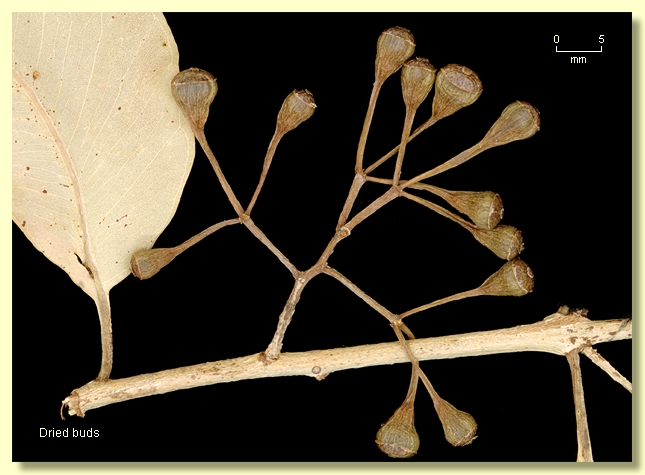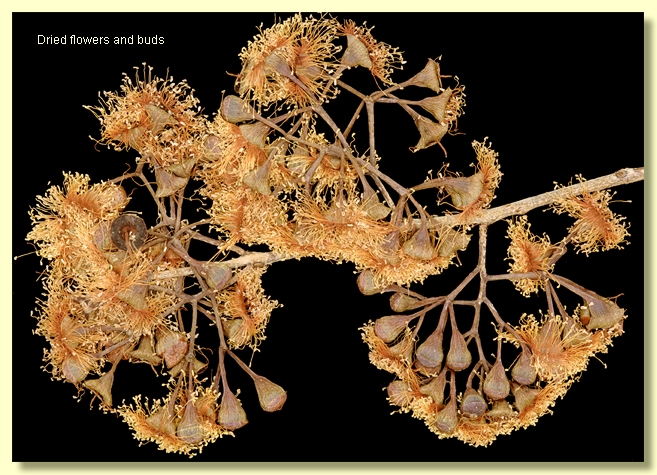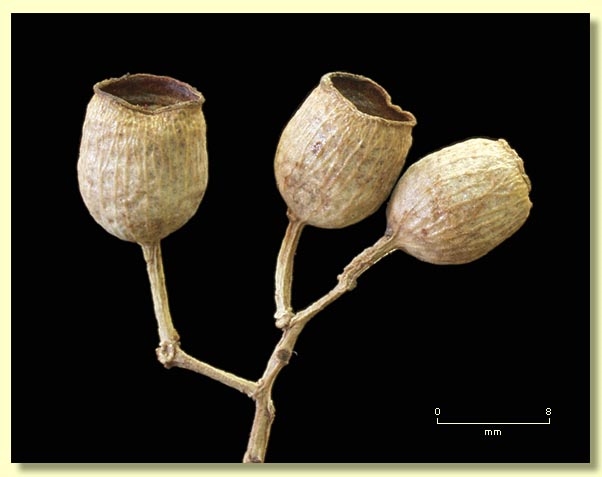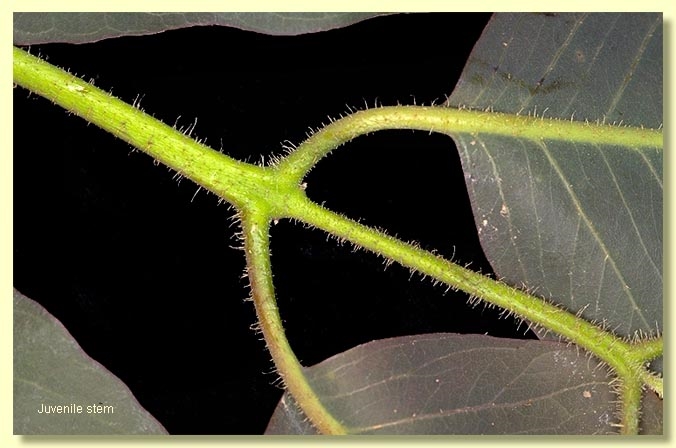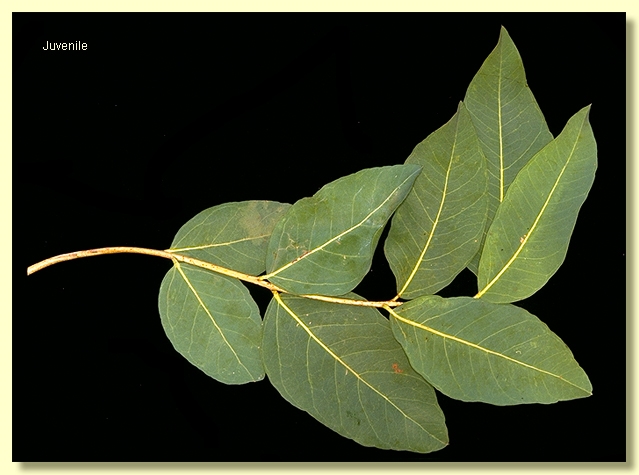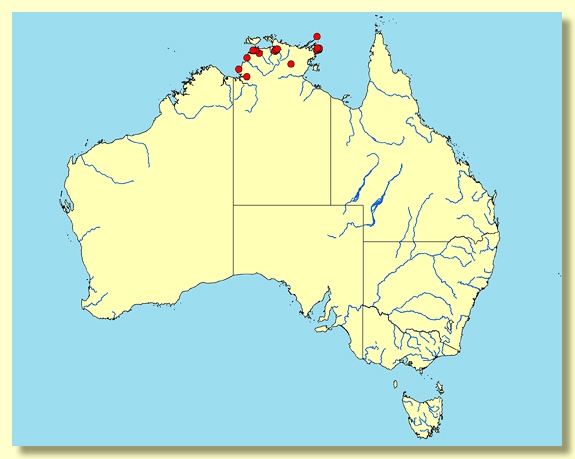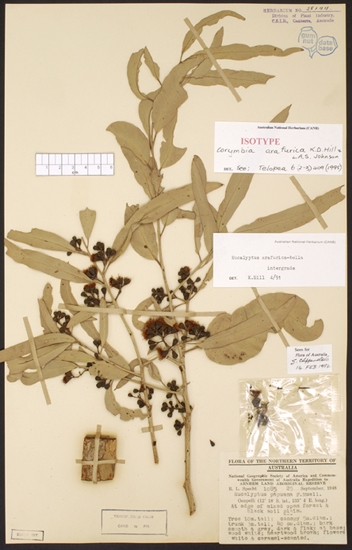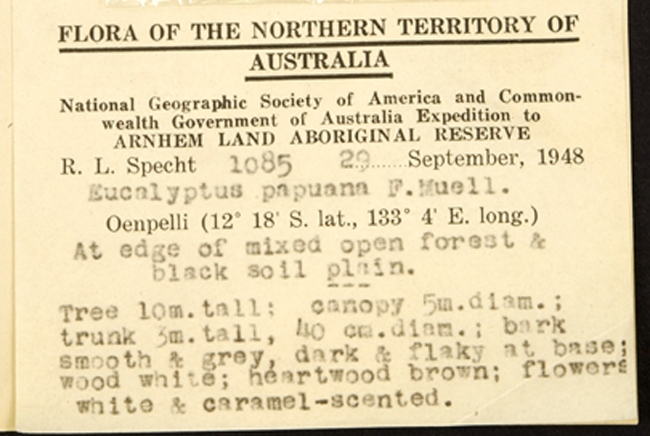Corymbia | Blakearia
Euclid - Online edition
Corymbia arafurica
Tree to 15 m tall. Forming a lignotuber.
Bark smooth throughout, powdery, white to creamy white or pale grey-brown; rarely with a short stocking of ± tessellated rough bark at the base of the trunk.
Branchlets lack oil glands in the pith; smooth.
Juvenile growth (coppice or field seedlings to 50 cm): stems rounded in cross-section, smooth or with a few very sparse bristle-glands; juvenile shortly leaves petiolate, opposite to sub-opposite, robustly ovate to lanceolate, 15–25 cm long, 7–12 cm wide, base rounded or tapering to petiole, apex rounded and apiculate or pointed, margin entire or coarsely indented, green, dull, sparsely setose soon becoming glabrous.
Adult leaves alternate, petioles 0.5–2.6 cm long; blade lanceolate, 8–20.7 cm long, 1.3–5.5 cm wide, undulate, base tapering to petiole or rounded, margin entire, apex pointed, undulate, concolorous, glossy, green, side-veins at less than or greater than 45° to midrib, reticulation dense to very dense, intramarginal vein present, oil glands apparently absent.
Inflorescence axillary compound, rarely terminal to the branchlet, with an expanded rhachis up to 5 internodes, the basal internode 0.6–2 cm long and subsequent internodes each 0.2 to 0.7 cm long, peduncles variable within an inflorescence, 0.1–0.9 cm long; buds 3 or 7 per umbel, pedicellate (pedicels 0.2–1.1 cm long. Mature buds pyriform (0.5–0.8 cm long, 0.4–0.6 cm wide), smooth, scar present (outer operculum shed early), operculum shallowly rounded and sometimes apiculate, stamens inflexed, all fertile, anthers ± cuboid, dorsifixed, versatile, dehiscing by longitudinal slits, style long and straight, stigma blunt, locules 3(4), the ovules irregularly arranged on the placentae. Flowers creamy white, perfumed.
Fruit pedicellate (pedicels 0.5–1.2 cm long), cylindrical to barrel-shaped, less commonly urceolate or ± obconical, 0.9–1.2 cm long, 0.6–1 cm wide, thin-walled, disc descending vertically, valves 3, enclosed.
Seeds brown, 3–7 mm long, saucer-shaped, smooth, hilum ventral.
Cultivated seedlings (measured at ca node 10): not grown.
Flowering time unknown.
A ghost gum tree restricted to the wetter areas of the monsoonal Top End of the Northern Territory, where it occurs on river levees and other low-lying areas especially near the coast. Found from Port Keats to Darwin and east to Oenpelli and Yirrkala, extending to the Wessel Islands. Corymbia arafurica has a white smooth trunk and often some patchy imperfectly shed bark near the base, with a green crown of alternate, petiolate, lanceolate, dull leaves, and, characteristically, broadly lanceolate juvenile leaves 7–12 cm wide.
C. arafurica differs from the closely related C. bella only in the much larger juvenile leaves (less than 3 cm wide in C. bella ). It also has a more northerly distribution than C. bella, occurring on the fringe of land bordering the Arafura Sea, though the ranges of the two species do overlap. The other prominently large-leaved ghost gum in this area is the smooth-barked C. grandifolia which has a crown of broad, glossy, leaves and buds and fruit with much longer pedicels (0.8–5 cm long depending on the subspecies).
MORE ABOUT CORYMBIA
MORE ABOUT GHOST GUMS
Corymbia arafurica: referring to the occurrence of this species near the Arafura Sea.



